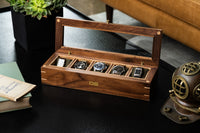Old military watches are a fantastic entry point into the larger watch collecting world in general, and the vintage watch world in particular.
Why an entry point to vintage watches, specifically? Because most militaries don’t really issue watches to individual soldiers anymore. In fact, in many militaries, soldiers are responsible for buying their own watch. Once upon a time, soldiers, sailors and airmen were sometimes given a specific, approved timepiece for use during their time in the armed forces. Some of these are rare and truly expensive today, such as the Rolex “mil-Sub,” but many are plentiful, inexpensive to collect, and a joy to wear.
 Rolex Submariner 'Milsub' by Gear Patrol
Rolex Submariner 'Milsub' by Gear Patrol
So why are military watches so cool? Because:
Not every military-issued watch saw service in a combat role — but many did. Whether on the wrist of an EOD diver, a special operator, a paratrooper, a door gunner, or any other number of specialties, these timepieces were out in the world, getting their straps dirty.
While the ultra-rare “mil-Subs” of the world will cost you the equivalent of a small home these days, there are myriad military watches that’ll run you much less. From quartz Navigator watches to mechanical GG-W-113s, these awesome timepieces are not only collectible, but affordable, too.
It goes without saying that something made to withstand the rigors of life in the field would be robust and well designed, no? Whether made from stainless steel — or even from thermoplastic! — military watches are made to take a licking and keep on ticking.
Maybe it’s just us, but we find the simple, utilitarian nature of military watches makes for timepieces that are inherently handsome. And while you can certainly find an ugly duckling amidst the embarrassment of military pieces out there, it’s tough to do.
It goes without saying that even if your military watch only saw service on the wrist of an office-bound clerk during World War II, it still exudes an aura of historical mystique that is very much real. Military watches are historical items, and deserve to be treated with respect.
Man, are there a lot of different military watches! In fact, one could conceivably collect just a narrow slice of the market for an entire lifetime — say, just Rolex and Tudor mil-Subs. Whether you dig chronographs, divers, field watches, or whatever, military watches truly offer something for everyone.
Because most military watches are physically covered in serial numbers, requisition numbers, dates, etc, it’s often possible to trace their production timelines, delivery, and other information. Many militaries keep pretty great logs of this information, and much of it has ended up online due to collector enthusiasm.
So with that, let’s get into some specific watches:
GG-W-113 and MIL-W-46374

Marathon/Gallet Military IN THE SHOP
These pieces were made by various companies such as Benrus, Hamilton and Marathon for issue to American, Canadian and other service members from the 1960s through the early 2000s. Earlier DTU-2A/P variants — the sort of progenitor of the GG-W-113 and MIL-W-46374 watches — were used in Vietnam, while more recent MIL-W-46374 were used in Desert Storm. You can find these watches all day long on eBay, but be aware that certain variants weren’t meant to be serviced, but rather, to be discarded. We carry these watches from time to time and of course, make sure they’re fully serviced and in working order.

Marathon/Gallet Navigator

Gallet x L.L. Bean Military Diver/Navigator
This neat watch with its signature asymmetric case was designed at the behest of an officer at Kelly Air Force Base in the 1980s. The oldest Marathon-Gallet version features a steel case, while the more modern features a thermoplastic case and a hi-torque quartz movement — and before you freak out over the quartz movement, understand that the use case for these pieces was for paratroopers and hi-flying pilots, who needed robust, reliable timekeeping. Marathon still sells the modern plastic version, which was recently upgraded with a sapphire crystal. And it’s still wildly affordable.
The Dirty Dozen

The cinematic nickname is one given to a group of watches produced by — you guessed it — 12 manufacturers at the tail end of World War II on behalf of the British Ministry of Defense. Some of these manufacturers are well known today: Omega, I.W.C, Jaeger-LeCoultre. Others, such as Cyma, are less well known, but that brand’s W.W.Ws were actually the best made, encased in steel rather than cheaper chrome, and plentiful, at around 20,000 pieces produced. A real piece of WWII history for a couple thousands bucks? Count us in.
Monopusher Chronographs

Lemania Monopusher Chronograph
This category includes a few different models and references of chronographs that utilize a single pusher for start, stop and reset functions. Famous among these are several variants made by Lemania, the renowned movement manufacturer, some of which were issued to RAF (Royal Air Force) and CAF (Canadian Air Force) personnel. While they’re certainly not as affordable as run-of-the-mill field watches, they can often be had for under $10,000. Try to find an example with clear case back markings, which can denote RAF or CAF issue, as well as HS (Hydrographic Survey) or others — including nuclear submarine crews.













